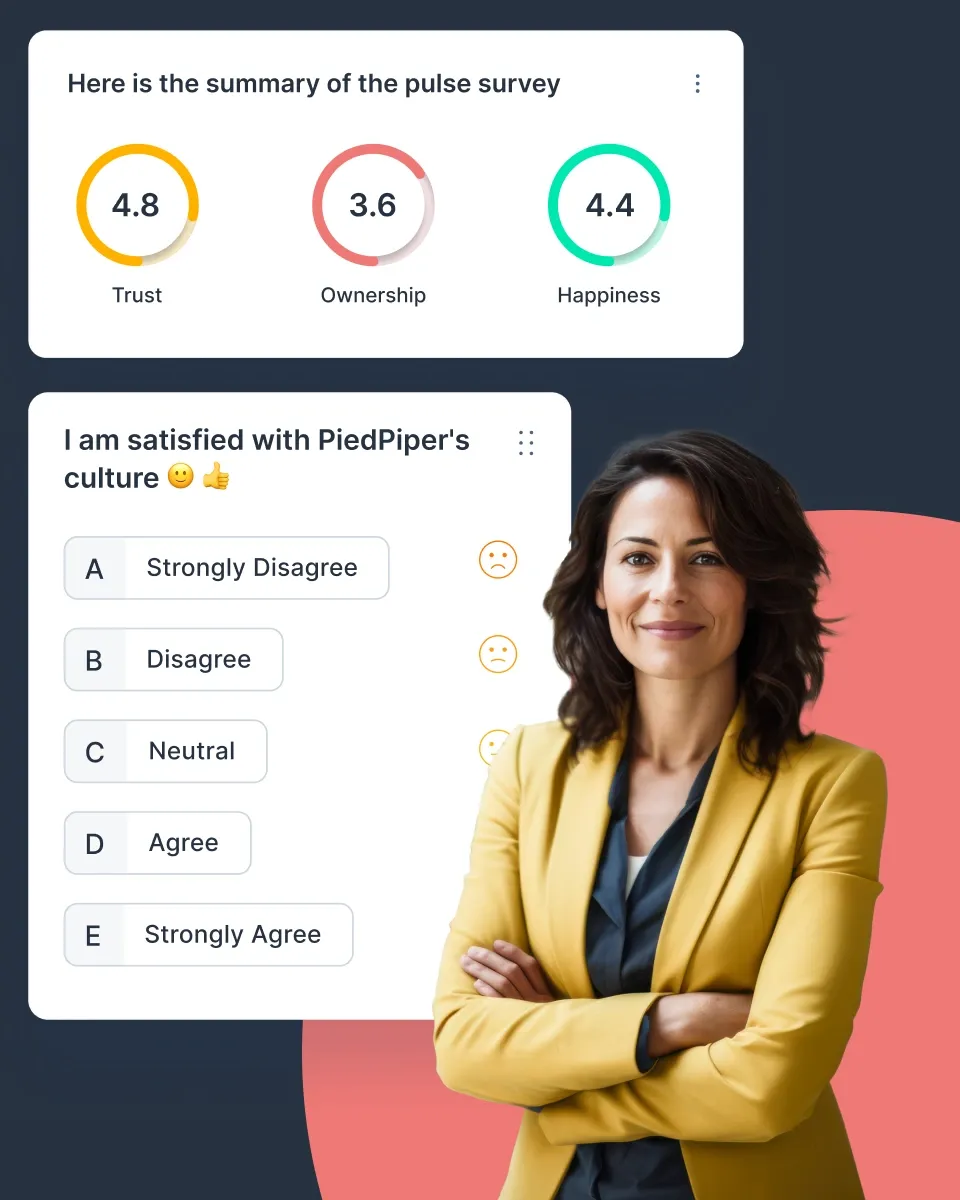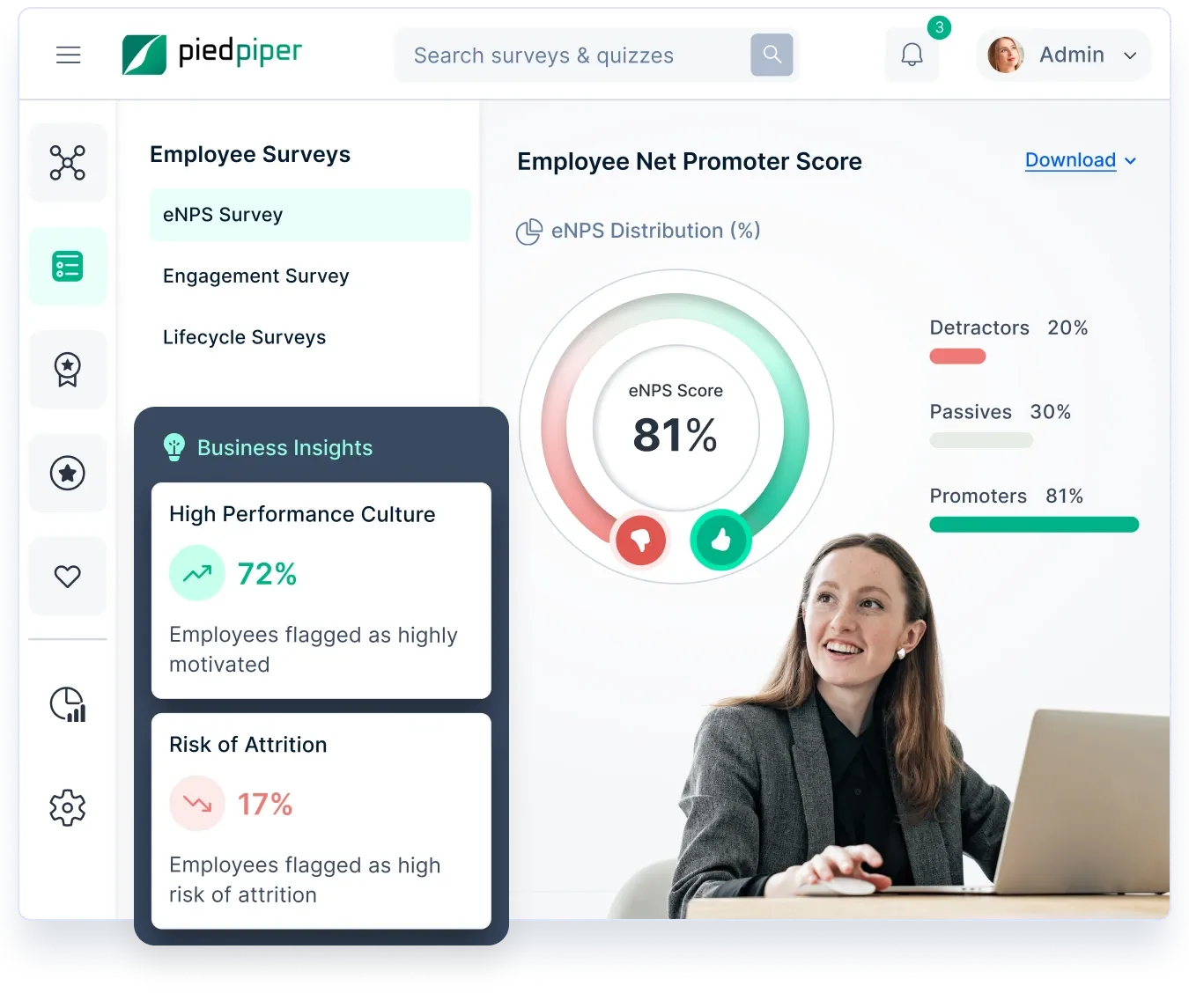Panduan Lengkap untuk Umpan Balik 360 Derajat: Proses, Pertanyaan, dan Contoh Umpan balik 360 derajat
Tinjauan umpan balik 360 derajat memberikan evaluasi yang menyeluruh dengan mengumpulkan wawasan dari para manajer, rekan kerja, bawahan, dan klien. Panduan ini mencakup proses umpan balik 360 derajat, pertanyaan-pertanyaan penting yang perlu diajukan, dan contoh-contoh praktis untuk membantu organisasi meningkatkan kinerja karyawan.

Di halaman ini
- Apa yang dimaksud dengan umpan balik 360 derajat?
- Apa saja yang harus disertakan dalam umpan balik 360 derajat?
- Mengapa menjalankan survei umpan balik 360 derajat itu penting?
- Umpan balik 360 derajat vs tinjauan kinerja
- Yang mana yang harus Anda gunakan?
- Seberapa efektifkah umpan balik 360 derajat?
- Batasan yang perlu dipertimbangkan
- Praktik terbaik untuk menjalankan program umpan balik 360 derajat yang efektif
- Kuesioner umpan balik 360 derajat yang komprehensif
- Contoh umpan balik 360 derajat
- Tingkatkan umpan balik 360 derajat dengan Empuls
- Kesimpulan
Survei umpan balik 360 derajat adalah salah satu cara yang paling efektif untuk mendapatkan evaluasi yang komprehensif atas kinerja karyawan. Tidak seperti tinjauan tradisional, yang hanya mengandalkan masukan dari manajer, umpan balik 360 derajat mengumpulkan wawasan dari rekan kerja, bawahan, manajer, dan bahkan klien untuk memberikan pandangan menyeluruh tentang kekuatan, kelemahan, dan dampak karyawan di tempat kerja.
Dengan menggunakan pertanyaan umpan balik 360 derajat yang terstruktur dengan baik, organisasi dapat menilai kemampuan komunikasi, efektivitas kepemimpinan, kerja sama tim, dan kemampuan memecahkan masalah. Proses ini tidak hanya meningkatkan kesadaran diri dan pertumbuhan profesional, namun juga mengurangi bias dan memberikan refleksi yang lebih akurat atas kontribusi karyawan.
Dalam panduan ini, kita akan membahas contoh-contoh umpan balik 360 derajat, pertanyaan-pertanyaan kunci yang perlu diajukan dalam survei umpan balik 360 derajat, dan praktik-praktik terbaik untuk memastikan wawasan yang dapat ditindaklanjuti. Baik Anda baru pertama kali menerapkan umpan balik 360 derajat atau ingin menyempurnakan pendekatan Anda, artikel ini akan membantu Anda memahami nilai dan dampaknya terhadap pengembangan karyawan.
Apa yang dimaksud dengan umpan balik 360 derajat?
Umpan balik 360 derajat adalah metode evaluasi kinerja di mana karyawan menerima umpan balik dari berbagai sumber, termasuk manajer, rekan kerja, bawahan, dan bahkan klien. Proses tinjauan holistik ini memberikan perspektif menyeluruh tentang kekuatan karyawan, area yang perlu ditingkatkan, dan dampak tempat kerja secara keseluruhan.
Tidak seperti tinjauan kinerja tradisional yang bersifat top-down, umpan balik 360 derajat mendorong wawasan konstruktif dari berbagai tingkat organisasi, membantu karyawan berkembang secara profesional, meningkatkan kolaborasi, dan menyelaraskannya dengan tujuan perusahaan.
Apa saja yang harus disertakan dalam umpan balik 360 derajat?
Proses umpan balik 360 derajat yang terstruktur dengan baik harus mencakup berbagai aspek kinerja, perilaku, dan pertumbuhan profesional karyawan. Proses ini biasanya mencakup umpan balik dari manajer, rekan kerja, bawahan, dan terkadang klien, yang memberikan pandangan holistik tentang kekuatan dan area yang perlu ditingkatkan.
- Keterampilan komunikasi: Seberapa efektif karyawan menyampaikan ide dan mendengarkan orang lain?
- Kolaborasi dan kerja sama tim: Seberapa baik mereka bekerja dengan rekan kerja dan berkontribusi pada lingkungan tim yang positif?
- Kepemimpinan dan pengambilan keputusan: Apakah mereka efektif dalam membimbing orang lain, mengambil inisiatif, dan membuat keputusan yang tepat?
- Kinerja dan produktivitas kerja: Apakah mereka memenuhi harapan, menghasilkan pekerjaan yang berkualitas, dan tetap bertanggung jawab?
- Kemampuan beradaptasi dan memecahkan masalah: Seberapa baik mereka menangani perubahan, tantangan, dan situasi yang tidak terduga?
- Etos kerja dan keandalan: Apakah mereka dapat diandalkan, proaktif, dan konsisten dalam tanggung jawab mereka?
- Kecerdasan emosional: Seberapa baik mereka mengelola emosi, menangani umpan balik, dan membangun hubungan yang kuat di tempat kerja?
- Pengembangan dan pembelajaran karier: Apakah mereka terbuka untuk belajar, meningkatkan keterampilan, dan pertumbuhan pribadi?
Memasukkan area-area ini ke dalam umpan balik 360 derajat memastikan evaluasi yang menyeluruh dan berwawasan luas yang membantu karyawan bertumbuh dan berkembang dalam peran mereka.
Mengapa menjalankan survei umpan balik 360 derajat itu penting?
Survei umpan balik 360 derajat memberikan evaluasi yang komprehensif terhadap kinerja karyawan dengan mengumpulkan wawasan dari berbagai sumber, termasuk manajer, rekan kerja, bawahan, dan klien. Tidak seperti tinjauan kinerja tradisional, metode ini mengurangi bias dan menawarkan perspektif yang lebih menyeluruh. Metode ini membantu karyawan memahami kekuatan mereka, mengidentifikasi area yang perlu ditingkatkan, dan meningkatkan hubungan di tempat kerja.
1. Menawarkan pandangan holistik tentang kinerja
Mengumpulkan umpan balik dari berbagai sumber memastikan evaluasi yang lebih seimbang dan adil atas kontribusi karyawan, daripada hanya mengandalkan perspektif manajer.
2. Mendorong pertumbuhan dan perkembangan profesional
Karyawan menerima wawasan yang berharga tentang kinerja mereka, sehingga mereka dapat menetapkan tujuan pengembangan pribadi dan bekerja di area yang perlu ditingkatkan.
3. Meningkatkan komunikasi dan kerja sama tim
Karyawan mendapatkan pemahaman yang lebih baik tentang bagaimana tindakan mereka berdampak pada kolega mereka, yang mengarah pada peningkatan kolaborasi, hubungan yang lebih kuat, dan lingkungan kerja yang lebih positif.
4. Mengurangi bias dalam evaluasi kinerja
Dengan menggabungkan umpan balik dari berbagai sumber, organisasi dapat meminimalkan bias pribadi dan memastikan penilaian yang lebih akurat dan adil terhadap karyawan.
5. Meningkatkan efektivitas kepemimpinan
Manajer dan pemimpin dapat mengidentifikasi kekuatan dan area yang perlu ditingkatkan dalam gaya kepemimpinan mereka, membantu mereka membangun hubungan yang lebih kuat dengan tim dan meningkatkan pengambilan keputusan.
Menjalankan survei umpan balik 360 derajat membantu organisasi menumbuhkan budaya transparansi, akuntabilitas, dan peningkatan berkelanjutan. Hal ini akan menghasilkan keterlibatan karyawan yang lebih baik, tingkat kinerja yang lebih tinggi, dan hubungan di tempat kerja yang lebih kuat
Umpan balik 360 derajat vs tinjauan kinerja
Baik tinjauan umpan balik 360 derajat maupun tinjauan kinerja tradisional merupakan alat yang penting untuk mengevaluasi kinerja karyawan, namun keduanya berbeda secara signifikan dalam hal pendekatan, tujuan, dan hasilnya. Memahami perbedaan-perbedaan ini dapat membantu organisasi memilih metode yang tepat untuk pengembangan karyawan dan penilaian kinerja.
Yang mana yang harus Anda gunakan?
- Gunakan tinjauan umpan balik 360 derajat jika tujuannya adalah untuk mengembangkan keterampilan kepemimpinan, meningkatkan komunikasi, dan meningkatkan kerja sama tim. Metode ini paling cocok untuk pertumbuhan pribadi dan pengembangan profesional.
- Gunakan tinjauan kinerja tradisional ketika berfokus pada produktivitas karyawan, pencapaian tujuan, dan penghargaan berbasis kinerja seperti promosi atau penyesuaian gaji.
Organisasi dapat mengambil manfaat dari menggabungkan kedua metode tersebut, menggunakan umpan balik 360 derajat untuk pertumbuhan karyawan dan tinjauan kinerja untuk evaluasi terstruktur, memastikan pendekatan holistik untuk manajemen talenta.
Seberapa efektifkah umpan balik 360 derajat?
Proses umpan balik 360 derajat sangat efektif jika diterapkan dengan benar, karena memberikan pandangan menyeluruh tentang kinerja, keterampilan, dan dampak tempat kerja karyawan.
Dengan mengumpulkan umpan balik dari berbagai sumber, termasuk manajer, rekan kerja, bawahan, dan klien, organisasi dapat memperoleh penilaian yang lebih akurat dan tidak bias mengenai kekuatan dan area yang perlu ditingkatkan.
1. Mendorong evaluasi yang menyeluruh
Karena umpan balik berasal dari berbagai perspektif, hal ini memberikan penilaian yang lebih komprehensif dan obyektif dibandingkan dengan tinjauan tradisional yang bersifat top-down.
2. Mendorong kesadaran diri dan pertumbuhan
Karyawan mendapatkan wawasan tentang kinerja dan interaksi di tempat kerja mereka, membantu mereka mengenali area yang perlu ditingkatkan dan mengembangkan keterampilan baru.
3. Meningkatkan efektivitas kepemimpinan dan manajemen
Para manajer menerima umpan balik yang konstruktif mengenai gaya kepemimpinan mereka, sehingga mereka dapat menyesuaikan pendekatan mereka dan mendukung tim mereka dengan lebih baik.
4. Memperkuat hubungan di tempat kerja dan kerja sama tim
Karyawan memahami bagaimana tindakan mereka memengaruhi orang lain, yang mengarah pada kolaborasi, komunikasi, dan resolusi konflik yang lebih baik.
5. Mengurangi bias dan subjektivitas
Ulasan tradisional sering kali bergantung pada satu sudut pandang, yang bisa menjadi bias. Umpan balik 360 derajat memastikan penilaian yang lebih seimbang dengan menggabungkan berbagai sudut pandang.
6. Meningkatkan keterlibatan dan retensi karyawan
Ketika karyawan merasa didengar dan menerima umpan balik yang dapat ditindaklanjuti, mereka akan lebih termotivasi dan berkomitmen terhadap peran mereka.
Batasan yang perlu dipertimbangkan
Meskipun umpan balik 360 derajat efektif, namun harus dilakukan dengan benar untuk menghindari perangkap yang umum terjadi. Organisasi harus memastikan:
- Anonimitas dan kerahasiaan untuk mendorong umpan balik yang jujur.
- Tujuan yang jelas sehingga karyawan memahami tujuan dari proses tersebut.
- Tindak lanjut yang dapat ditindaklanjuti untuk menangani umpan balik dan mengimplementasikan perbaikan.
Ketika digunakan secara strategis, umpan balik 360 derajat membantu karyawan tumbuh, memperkuat kepemimpinan, dan menumbuhkan budaya perbaikan berkelanjutan, menjadikannya alat yang ampuh untuk kesuksesan pribadi dan organisasi.

Membuka Potensi Penuh dari Umpan Balik 360 Derajat
Dapatkan wawasan komprehensif mengenai kinerja karyawan dengan survei umpan balik 360 derajat yang terstruktur, anonim, dan berbasis data. Empuls membantu Anda mengumpulkan, menganalisis, dan menindaklanjuti umpan balik untuk mendorong pertumbuhan dan peningkatan yang berkelanjutan.
Praktik terbaik untuk menjalankan program umpan balik 360 derajat yang efektif
Temukan panduan praktik terbaik untuk program umpan balik 360 derajat yang dapat menjadi alat kinerja paling ampuh bagi perusahaan Anda.
1. Pilih area fokus Anda
Program umpan balik 360 derajat akan memberi Anda wawasan dari seluruh perusahaan Anda. Pada saat yang sama, umpan balik tidak berguna kecuali jika Anda menindaklanjutinya. Anda tidak bisa mengerjakan semuanya secara bersamaan, jadi Anda perlu mengidentifikasi berbagai kategori umpan balik yang memiliki prioritas lebih tinggi atau lebih rendah dari yang lain, seperti kebutuhan untuk memotivasi tenaga kerja milenial atau meningkatkan komunikasi internal.
Memilih area fokus juga akan membantu ketika memilih pertanyaan yang Anda ajukan kepada orang-orang.
Misalnya, jika Anda berfokus pada memastikan keragaman di tempat kerjapertanyaan Anda akan berbeda dengan pertanyaan yang mungkin diajukan jika Anda mencoba meningkatkan efisiensi operasional. Ingatlah bahwa Anda dapat menanggapi umpan balik lainnya nanti.
Anda perlu mengetahui apa yang harus ditargetkan terlebih dahulu untuk memastikan bahwa Anda mendapatkan hasil awal yang akan mendorong anggota organisasi lainnya untuk melakukan proses dengan serius.
2. Ciptakan budaya umpan balik
Tidak ada karyawan, termasuk para pemimpin, yang boleh dikecualikan dari menerima umpan balik.
"Kepemimpinan adalah target yang terus bergerak, dan akan selalu demikian. Jika Anda ingin menjadi pemimpin yang lebih baik, merasa nyaman dengan perubahan. Dan jika Anda ingin memimpin, belajarlah untuk berpikir seperti seorang pemimpin. Pikirkan orang, pikirkan kemajuan, dan pikirkan hal-hal yang tak berwujud." - John C. Maxwell, penulis buku 360 Degree Leader.
Menciptakan budaya umpan balik bermanfaat bagi individu yang bekerja untuk Anda dan perusahaan secara keseluruhan. Hal ini juga membantu meningkatkan cara penyampaian produk Anda dan mengoptimalkan pengalaman pelanggan dengan menciptakan budaya yang membuat orang lebih terlibat dengan pekerjaan yang mereka lakukan, sebagian karena mereka tahu bahwa mereka mempelajari hal-hal baru dan meningkatkan keterampilan mereka hampir setiap hari.
3. Ajukan pertanyaan yang tepat
Seperti halnya pengumpulan data lainnya, Anda perlu mendapatkan parameter yang benar jika ingin hasilnya valid. Program umpan balik 360 derajat bermuara pada mengajukan pertanyaan yang tepat kepada orang-orang.
Jika organisasi Anda cukup besar, Anda dapat menguji program Anda dengan sampel kecil karyawan untuk melihat apakah pertanyaan Anda mengarah pada jawaban yang Anda cari. Jika tidak, saatnya untuk mengubah pertanyaan.
Hal ini dapat membantu Anda memulai dengan melihat area fokus Anda dan mengidentifikasi karyawan mana yang akan Anda ajak bicara. Pertanyaan yang akan Anda ajukan kepada manajemen senior akan sangat berbeda dengan pertanyaan yang akan Anda ajukan kepada karyawan tingkat pemula.
Pertimbangkan untuk mengajukan pertanyaan tentang kemampuan kepemimpinan, kemampuan komunikasi, kreativitas, bekerja dengan tim, dan banyak lagi. Ingatlah bahwa lebih baik memiliki terlalu banyak data daripada terlalu sedikit data, namun menambah jumlah titik data juga akan menambah waktu yang dibutuhkan untuk melaksanakan program.
4. Menindaklanjuti dengan orang-orang
Memiliki akses ke data hanya akan membawa Anda sejauh ini, dan jika Anda gagal menindaklanjuti informasi yang Anda kumpulkan, program umpan balik 360 derajat tidak akan membawa Anda ke mana-mana. Luangkan waktu untuk berbagi umpan balik dengan karyawan dan kemudian bekerja sama dengan mereka untuk mengembangkan rencana tindakan untuk mengatasi umpan balik tersebut.
Setelah Anda mengembangkan rencana, pastikan Anda tetap berpegang teguh pada rencana tersebut dan memeriksa kembali dengan karyawan dari waktu ke waktu.
Mengikuti proses ini juga akan membantu saat Anda menjalankan program umpan balik di lain waktu karena Anda akan memiliki poin data untuk membandingkan hasil yang baru. Jika Anda telah mengidentifikasi masalah, mengomunikasikannya dengan benar, dan menindaklanjutinya dengan karyawan dari waktu ke waktu, Anda akan melihat peningkatan yang nyata dalam kinerja mereka dari waktu ke waktu.
5. Buatlah secara teratur
Kami tidak bisa cukup menekankan di sini bahwa konsistensi adalah kuncinya. Dengan menjadikan program umpan balik yang berkelanjutan sebagai norma baru di perusahaan Anda, Anda membantu menciptakan budaya umpan balik yang kami sebutkan di poin kedua.
Dengan melakukan upaya ini secara teratur, Anda membantu memastikan bahwa semua orang di perusahaan tahu apa yang diharapkan dan ingin mengharapkannya alih-alih memberikan kejutan yang tidak diinginkan kepada mereka.
Seolah-olah hal tersebut belum cukup, membuat program umpan balik yang lebih teratur dapat membantu orang mengatasi kelemahan mereka dengan lebih cepat daripada membiarkan mereka melakukan kesalahan yang sama selama berbulan-bulan atau bahkan bertahun-tahun. Seperti yang telah kami jelaskan pada poin terakhir, jika Anda membuat program umpan balik secara teratur, Anda dapat melacak peningkatan selama periode intervensi.
6. Gunakan dengan sungguh-sungguh untuk pertumbuhan pribadi karyawan
Salah satu tantangan dalam menerapkan program umpan balik 360 derajat adalah mendapatkan dukungan dan keterlibatan dari karyawan. Di beberapa perusahaan, hal ini terjadi karena karyawan khawatir bahwa memberikan umpan balik yang jujur tentang rekan kerja mereka dapat masuk ke dalam tinjauan tahunan dan mempengaruhi apakah mereka akan diberi bonus atau bahkan dihukum.
Penelitian telah menunjukkan bahwa Generasi Milenial/Generasi Y menginginkan umpan balik dan pelatihan 50 persen lebih banyak daripada generasi lain di dunia kerja.
Anda harus berusaha keras untuk mendorong karyawan Anda agar mempercayai proses tersebut. Ini berarti mengomunikasikan untuk apa umpan balik akan digunakan dan memastikan bahwa Anda menghormati kesepakatan tersebut. Kepercayaan adalah bagian penting dari proses ini, dan jika Anda melanggar kepercayaan tersebut, Anda akan kesulitan mengumpulkan data dan wawasan yang akurat.
7. Menguji dan meningkatkan
Mereka mengatakan bahwa kegilaan adalah melakukan hal yang sama berulang kali dan mengharapkan hasil yang berbeda. Hal ini terutama berlaku ketika menerapkan program umpan balik 360 derajat. Sebaiknya Anda mengguncang segalanya, menguji berbagai pendekatan dan mengidentifikasi elemen-elemen yang membuat proses umpan balik Anda menjadi lebih efisien.
Mereka juga mengatakan bahwa variasi adalah bumbu kehidupan, dan ada alasannya. Melakukan perubahan dan peningkatan secara berkelanjutan membantu Anda mendapatkan keuntungan marjinal, yang berarti melakukan perbaikan kecil yang akan bertambah menjadi peningkatan yang lebih besar dari waktu ke waktu.
Tetaplah dengan apa yang berhasil dan kemudian lanjutkan dengan menguji sesuatu yang lain untuk memastikan Anda menerima umpan balik yang paling dapat ditindaklanjuti.
Kuesioner umpan balik 360 derajat yang komprehensif
Survei umpan balik 360 derajat yang terstruktur dengan baik memberikan wawasan yang berharga tentang kekuatan karyawan, area untuk perbaikan, dan dampak keseluruhan di tempat kerja. Dengan mengumpulkan umpan balik dari manajer, rekan kerja, bawahan, dan klien, organisasi dapat melakukan tinjauan umpan balik 360 derajat yang adil dan menyeluruh yang mendukung pertumbuhan profesional dan pengembangan tim.
1. Komunikasi dan kolaborasi
- Seberapa efektif karyawan berkomunikasi dengan kolega dan pemangku kepentingan?
- Apakah karyawan secara aktif mendengarkan dan menanggapi umpan balik secara konstruktif?
- Seberapa baik karyawan berkontribusi dalam diskusi tim dan sesi curah pendapat?
- Apakah karyawan mengkomunikasikan ide dengan jelas dan ringkas?
- Seberapa efektif karyawan menyesuaikan gaya komunikasi mereka untuk audiens yang berbeda?
2. Kepemimpinan dan pengambilan keputusan
- Seberapa efektif karyawan tersebut memimpin proyek atau inisiatif?
- Apakah karyawan membuat keputusan berdasarkan informasi yang memadai di bawah tekanan?
- Seberapa baik karyawan memberikan panduan dan dukungan kepada rekan kerja?
- Apakah karyawan mendelegasikan tugas dengan tepat dan memberdayakan orang lain untuk mengambil tanggung jawab?
- Seberapa efektif karyawan menginspirasi dan memotivasi tim mereka?
3. Etos kerja dan akuntabilitas
- Apakah karyawan mengambil tanggung jawab atas tugas dan tanggung jawab mereka?
- Seberapa efektif karyawan memenuhi tenggat waktu dan menghasilkan pekerjaan berkualitas tinggi?
- Apakah karyawan menunjukkan keandalan dan profesionalisme dalam perannya?
- Seberapa baik karyawan memprioritaskan dan mengelola beban kerja mereka?
- Apakah karyawan mengambil inisiatif dalam mengidentifikasi dan mengatasi masalah?
4. Pemecahan masalah dan kemampuan beradaptasi
- Seberapa baik karyawan menangani tantangan dan situasi yang tidak terduga?
- Apakah karyawan menunjukkan kreativitas dalam memecahkan masalah yang berhubungan dengan pekerjaan?
- Seberapa efektif karyawan beradaptasi dengan perubahan di tempat kerja?
- Apakah karyawan tetap tenang dan berorientasi pada solusi di bawah tekanan?
- Seberapa baik karyawan menyeimbangkan pengambilan risiko dengan pemikiran strategis?
5. Kecerdasan emosional dan perilaku di tempat kerja
- Seberapa baik karyawan menangani kritik yang membangun?
- Apakah karyawan mempertahankan sikap positif dan hormat di tempat kerja?
- Seberapa efektif karyawan mengelola konflik di tempat kerja?
- Apakah karyawan menunjukkan empati dan perhatian terhadap rekan kerja?
- Seberapa baik karyawan menangani stres dan mempertahankan ketenangan dalam situasi sulit?
6. Pertumbuhan dan pengembangan profesional
- Apakah karyawan secara aktif mencari peluang pembelajaran dan pengembangan?
- Seberapa terbuka karyawan terhadap umpan balik dan peningkatan diri?
- Apakah karyawan mengambil inisiatif untuk mengembangkan keterampilan dan pengetahuan mereka?
- Seberapa efektif karyawan menerapkan pembelajaran baru dalam pekerjaan mereka?
- Apakah karyawan mendukung pertumbuhan dan perkembangan rekan kerja mereka?
7. Manajemen pelanggan dan pemangku kepentingan
- Seberapa efektif karyawan mengelola hubungan dengan klien dan pemangku kepentingan?
- Apakah karyawan menangani masalah dan umpan balik pelanggan secara profesional?
- Seberapa baik karyawan mewakili organisasi dalam interaksi eksternal?
- Apakah karyawan secara proaktif mencari cara untuk meningkatkan kepuasan pelanggan?
- Seberapa efektif karyawan menyeimbangkan prioritas internal dan eksternal?
Contoh-contoh umpan balik 360 derajat ini membantu organisasi mengumpulkan wawasan yang komprehensif, konstruktif, dan dapat ditindaklanjuti yang mendorong pengembangan karyawan dan kesuksesan tim. Tinjauan umpan balik 360 derajat yang terstruktur memastikan karyawan menerima umpan balik yang menyeluruh untuk meningkatkan kemampuan komunikasi, kepemimpinan, dan pemecahan masalah mereka

Akses Templat Survei Umpan Balik 360 Derajat yang Siap Digunakan
Berikan umpan balik 360 derajat secara lancar dengan templat survei yang dibuat oleh para ahli. Kumpulkan wawasan dari berbagai perspektif dan dapatkan umpan balik yang dapat ditindaklanjuti untuk meningkatkan pengembangan karyawan.
Contoh umpan balik 360 derajat
Survei umpan balik 360 derajat memberikan wawasan yang menyeluruh tentang kinerja karyawan dengan mengumpulkan umpan balik dari manajer, rekan kerja, bawahan, dan klien. Agar umpan balik dapat ditindaklanjuti, penting untuk menyusun tanggapan dengan cara yang positif, negatif, atau konstruktif.
Contoh umpan balik positif
- "Anda mengomunikasikan ide-ide Anda dengan jelas dan memastikan bahwa semua orang memahami poin-poin penting dalam rapat. Kemampuan Anda untuk secara aktif mendengarkan dan terlibat dalam diskusi memperkuat kolaborasi tim."
- "Keterampilan kepemimpinan Anda sangat menginspirasi. Anda menetapkan ekspektasi yang jelas, mendelegasikan tugas secara efektif, dan mendukung tim Anda dalam mencapai tujuan mereka."
- "Anda menangani banyak proyek secara efisien dan secara konsisten memenuhi tenggat waktu. Keterampilan manajemen waktu Anda adalah aset yang sangat berharga bagi tim."
- "Kemampuan pemecahan masalah Anda luar biasa. Anda menganalisis tantangan dengan cermat dan mengusulkan solusi praktis yang bermanfaat bagi seluruh tim."
- "Anda membina lingkungan kerja yang positif dan inklusif dengan bersikap ramah dan mendukung rekan kerja Anda."
- "Kemampuan beradaptasi Anda patut dipuji. Anda menerima perubahan dengan antusias dan membantu memandu orang lain melalui transisi dengan lancar."
- "Kesediaan Anda untuk membantu orang lain dan berbagi keahlian Anda memperkuat kinerja tim secara keseluruhan."
- "Anda mengelola konflik di tempat kerja secara profesional dan memastikan bahwa diskusi tetap produktif dan berfokus pada solusi."
- "Anda secara konsisten memberikan hasil kerja berkualitas tinggi dengan perhatian yang besar terhadap detail. Komitmen Anda terhadap keunggulan memberikan teladan yang kuat bagi orang lain."
- "Anda menunjukkan rasa tanggung jawab yang kuat dan mengambil alih tanggung jawab Anda, memastikan bahwa tugas-tugas diselesaikan secara efektif."
Contoh umpan balik negatif
- "Komunikasi Anda bisa menjadi lebih jelas, karena beberapa anggota tim kesulitan memahami instruksi Anda. Menyederhanakan pesan Anda akan meningkatkan kolaborasi."
- "Anda sering melewatkan tenggat waktu, yang memengaruhi alur kerja tim secara keseluruhan. Manajemen waktu yang lebih baik dapat membantu meningkatkan efisiensi."
- "Gaya kepemimpinan Anda terkadang tidak konsisten, sehingga menimbulkan kebingungan di dalam tim. Memberikan arahan yang lebih jelas akan meningkatkan keselarasan tim."
- "Anda cenderung bekerja secara mandiri dan tidak selalu melibatkan orang lain dalam pengambilan keputusan, yang memengaruhi kerja sama tim. Kolaborasi yang lebih besar akan bermanfaat."
- "Anda kesulitan untuk beradaptasi ketika terjadi perubahan, sehingga menyulitkan tim untuk menyesuaikan diri dengan cepat. Menjadi lebih fleksibel akan membantu dalam menangani pergeseran prioritas."
- "Tanggapan Anda terhadap umpan balik terkadang bisa terkesan defensif, sehingga menyulitkan orang lain untuk memberikan masukan yang konstruktif."
- "Anda sering menunda merespons email dan pesan, yang memperlambat kemajuan proyek. Meningkatkan daya tanggap komunikasi akan bermanfaat bagi tim."
- "Anda terkadang kesulitan dalam memprioritaskan tugas, sehingga terburu-buru di menit-menit terakhir. Merencanakan ke depan akan membantu mengelola beban kerja dengan lebih efektif."
- "Interaksi Anda dengan rekan kerja terkadang terasa lebih bersifat transaksional daripada kolaboratif. Memperkuat hubungan di tempat kerja akan meningkatkan dinamika tim."
- "Anda bisa saja ragu-ragu untuk mengambil inisiatif, yang terkadang berakibat pada hilangnya kesempatan. Menjadi lebih proaktif dapat memberikan dampak positif terhadap kontribusi Anda."
Contoh-contoh umpan balik yang konstruktif
- "Presentasi Anda informatif, tetapi menambahkan lebih banyak elemen visual dapat membuatnya lebih menarik dan lebih mudah diikuti."
- "Anda menyumbangkan ide-ide berharga selama rapat, tetapi membiarkan orang lain berbagi perspektif mereka sebelum memberikan tanggapan akan mendorong lebih banyak kolaborasi."
- "Kemampuan Anda dalam mengelola beberapa proyek sangat mengesankan, namun menetapkan prioritas yang lebih jelas dapat membantu mengurangi stres di menit-menit terakhir dan meningkatkan efisiensi."
- "Anda memiliki keterampilan teknis yang kuat, tetapi meningkatkan kemampuan Anda untuk menjelaskan konsep yang rumit dengan istilah yang lebih sederhana akan bermanfaat bagi tim."
- "Kepemimpinan Anda efektif, namun memberikan pengakuan yang lebih sering kepada anggota tim Anda dapat meningkatkan semangat kerja."
- "Anda bertanggung jawab atas pekerjaan Anda, namun meminta bantuan saat dibutuhkan dapat membuat proyek berjalan lebih lancar dan mengurangi stres yang tidak perlu."
- "Umpan balik Anda kepada orang lain sangat berharga, namun menyampaikannya dengan nada yang lebih mendukung dapat mendorong penerimaan dan tindakan yang lebih besar."
- "Anda sangat fokus pada tugas-tugas Anda, tetapi berpartisipasi dalam lebih banyak inisiatif lintas tim dapat membantu memperluas dampak Anda di perusahaan."
- "Anda menangani tantangan dengan baik, tetapi berbagi pelajaran yang dipetik dari situasi sulit dapat membantu orang lain mendapatkan manfaat dari pengalaman Anda."
- "Kemampuan pemecahan masalah Anda sangat kuat, namun meluangkan waktu untuk mempertimbangkan pendekatan alternatif sebelum mengambil keputusan dapat memberikan hasil yang lebih baik."
Contoh-contoh umpan balik 360 derajat ini membantu memastikan umpan balik yang spesifik, dapat ditindaklanjuti, dan mendukung, sehingga karyawan dapat meningkatkan kinerja, meningkatkan kolaborasi, dan tumbuh secara profesional.
Tingkatkan umpan balik 360 derajat dengan Empuls

Proses umpan balik 360 derajat yang terstruktur dengan baik membantu organisasi mendapatkan pemahaman yang lengkap mengenai kinerja karyawan dengan mengumpulkan wawasan dari manajer, rekan kerja, bawahan, dan klien. Namun, tanpa alat bantu yang tepat, umpan balik bisa jadi tidak konsisten, bias, atau sulit ditindaklanjuti.
Dengan Empuls, organisasi dapat merampingkan tinjauan umpan balik 360 derajat mereka dengan:
- Menjalankan survei umpan balik 360 derajat yang otomatis, anonim, dan dapat disesuaikan.
- Mengumpulkan wawasan yang komprehensif dari berbagai perspektif untuk evaluasi yang menyeluruh.
- Menggunakan analitik berbasis AI untuk mengidentifikasi kekuatan, area peningkatan, dan peluang pengembangan.
- Melacak kemajuan karyawan dan mendorong pertumbuhan dan keterlibatan yang berkelanjutan.
Dengan memanfaatkan Empuls, bisnis dapat mengubah umpan balik menjadi tindakan, membantu karyawan berkembang, meningkatkan kolaborasi, dan mendorong kesuksesan organisasi.
Mulailah perjalanan umpan balik 360 derajat Anda dengan Empuls!
Kesimpulan
Program umpan balik 360 derajat yang dirancang dengan baik memiliki potensi untuk menjadi alat yang paling ampuh yang dapat diakses oleh perusahaan Anda. Lebih baik lagi, program ini akan terus meningkat seiring berjalannya waktu saat Anda mempelajari apa yang berhasil dan apa yang tidak, dan saat Anda terus meningkatkan perusahaan Anda.
Dalam beberapa kasus, hal ini dapat membuat perbedaan antara dua perusahaan dan memberikan salah satu dari mereka keunggulan kompetitif yang mereka butuhkan untuk naik ke puncak industri. Satu-satunya pertanyaan adalah apakah Anda siap untuk melakukan pekerjaan dan memanfaatkannya atau apakah Anda akan duduk dan membiarkan pesaing Anda menyalip Anda.





